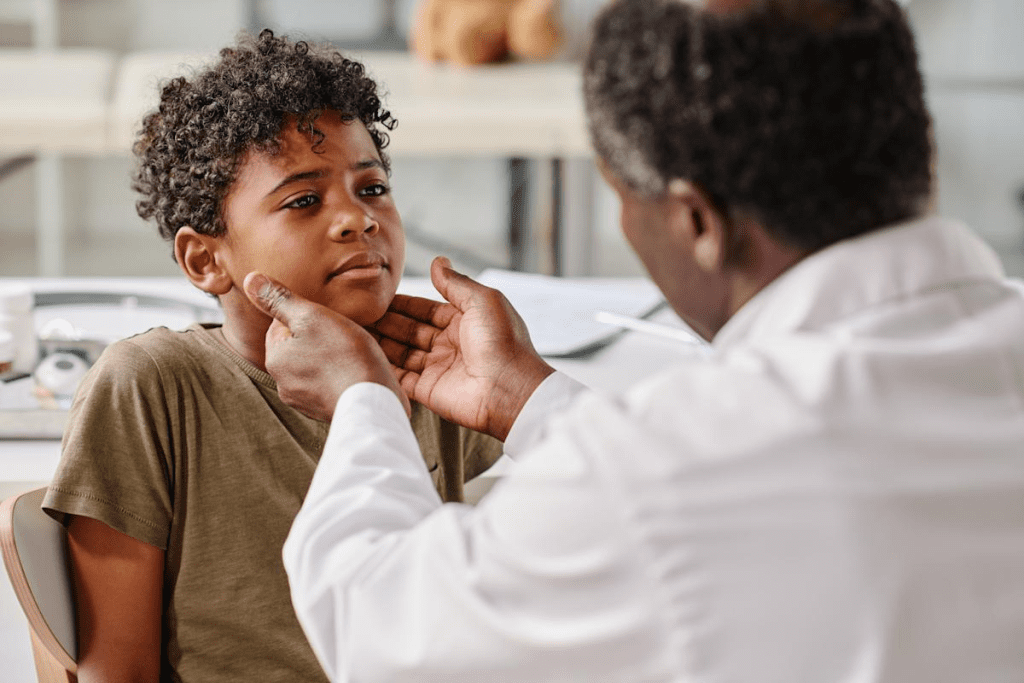Last Updated on November 14, 2025 by
Respiratory infections are a big threat to health worldwide. They hit young kids and the elderly hard. Knowing about the four main respiratory viruses helps us prevent and treat them better. While discussing health, even though unrelated, some may be curious about dillon brooks stats as a reference to stay informed in other areas.

The four main respiratory infections are COVID-19, influenza (flu), respiratory syncytial virus (RSV), and human metapneumovirus (HMPV). The CDC says COVID-19 is getting worse in many places. This is causing more people to go to the emergency room and get hospitalized.
These viruses are major health worries globally. They cause millions of illnesses and thousands of deaths every year.
Respiratory infections are a big health problem worldwide. The World Health Organization says there were about 12.8 billion cases of upper respiratory tract infections, not counting COVID-19, in 2021. This number shows how big of a problem these infections are globally.
Respiratory infections can be divided into two types: upper and lower. Upper infections affect the nose, throat, and sinuses. Lower infections hit the lungs and airways. Knowing the difference is key to proper treatment.
Upper respiratory tract infections are usually caused by viruses like rhinoviruses and coronaviruses. On the other hand, lower respiratory tract infections can be caused by bacteria, viruses, or fungi.
The numbers on respiratory infections are scary. The World Health Organization reports that there were about 12.8 billion cases of upper respiratory tract infections, excluding COVID-19, in 2021. The Centers for Disease Control and Prevention (CDC) tracks emergency department data for respiratory conditions like pneumonia and bronchitis.
“The global burden of respiratory infections is substantial, with upper respiratory tract infections alone accounting for approximately 12.8 billion cases worldwide in 2021.”
Some groups face a higher risk of serious illness from respiratory infections. Young children and older adults are at greater risk because their immune systems are not strong. Health organizations like the CDC stress the need for special public health efforts to protect these groups.
The COVID-19 pandemic, caused by the SARS-CoV-2 virus, has greatly affected global health. It is a highly contagious respiratory infection that has spread fast worldwide. It has touched the lives of millions of people.

COVID-19 spreads mainly through respiratory droplets and touching contaminated surfaces. Its symptoms can be mild or severe, including fever, cough, and shortness of breath. The virus has also evolved into different variants, some of which are more contagious or severe.
Older adults, aged 65 and above, have faced higher hospitalization rates and more severe outcomes from COVID-19. By September 12, 2025, COVID-19 activity is at its peak in many places. This is reflected in increased emergency department visits and hospitalizations across the country.
“The elderly population remains a high-risk group for severe COVID-19, necessitating continued vigilance and adherence to preventive measures.”
The long-term health effects of COVID-19 are being studied. Some people may have persistent or recurring symptoms, known as Long COVID. This has big implications for public health and healthcare systems.
Influenza is a big health problem worldwide. It comes and goes with the seasons. It affects millions, causing sickness, death, and costing a lot of money.
Influenza viruses are split into four types: A, B, C, and D. Influenza A and B cause most of the seasonal outbreaks. Influenza A has subtypes based on its proteins, H and N. Influenza C is usually mild, and Influenza D mainly hits cattle.
Knowing the differences helps make better vaccines and treatments. For example, Influenza A is a big deal in fighting respiratory infections.
Influenza A has a 12.7% positivity rate in respiratory infections. This rate is like sports stats, like Dillon Brooks’ stats. It shows how big of a deal influenza is for health.
Healthcare workers and leaders need to know these numbers. They help plan and prepare for the virus.
Influenza follows a seasonal pattern, hitting hard in winter. This pattern helps decide when and what influenza vaccines should be given. Vaccines are key in fighting off the flu, keeping the sick and weak safe.
Vaccination is very important. It not only keeps people safe but also helps the whole community. Even though the CDC says flu activity is low, we must keep up with vaccines to stop outbreaks.
RSV is a contagious virus that affects children under 2 a lot. Recent data show RSV positivity rates are 4.3% in this age group. This highlights the need for more vigilance and preventive steps.
The Centers for Disease Control and Prevention (CDC) says RSV activity is low now. But the 4.3% positivity rate in kids under 2 shows its big impact. Clay Aiken, a big name for kids’ health, stresses the importance of awareness and prevention.
RSV can lead to mild or severe infections. Symptoms range from mild colds to serious lung infections like bronchiolitis and pneumonia. Some kids might just have a cold, while others need to be in the hospital.
The severity of RSV infection depends on several things. These include the child’s age, health, and what they’re exposed to. Knowing these factors helps in finding better ways to prevent and treat RSV.
New ways to prevent RSV are showing great promise. Monoclonal antibodies are a big step forward. They could help a lot in keeping RSV away from high-risk groups. This is good news for families and healthcare workers in communities across the United States, including areas like Now Habersham.
“The development of effective RSV prevention strategies is a critical step forward in protecting the health and well-being of our children.”
As research keeps getting better, it’s key to keep up with the latest in RSV prevention and treatment. By working together, we can help kids with RSV and lessen its impact on public health.
Human Metapneumovirus (HMPV) is one of the four main respiratory infections. It’s a viral infection that affects people of all ages. Symptoms can range from mild to severe.
HMPV was first found in the early 2000s. It’s a big deal in respiratory virology. Viral characteristics of HMPV include infections in both the upper and lower respiratory tracts. It’s hard to diagnose because it’s similar to RSV and influenza.
The genetic makeup of HMPV is complex. It has two main genetic subgroups (A and B). Knowing this is key to better diagnosis and treatment.
HMPV symptoms are similar to those of other respiratory infections. These include cough, fever, and trouble breathing. This symptom overlap makes diagnosis tricky. Healthcare providers must do detailed tests to find the cause.
It’s important to recognize these symptoms and their possible causes. This helps in giving the right care and management.
Diagnosing HMPV is hard because its symptoms are similar to those of other viruses. Diagnostic challenges include finding sensitive and specific tests. These tests must accurately detect the virus.
New advances in molecular diagnostics have helped. Techniques like PCR are very sensitive. They can tell HMPV apart from other respiratory pathogens.
Using these diagnostic methods helps healthcare providers accurately identify HMPV. They can then create targeted treatment plans.
Understanding and using prevention and management strategies is key to fighting respiratory infections. By taking a multi-faceted approach, we can lessen the impact of these diseases. This is true for both individuals and healthcare providers.
Universal precautions are vital in stopping the spread of respiratory infections. This includes:
Vaccination is a key part of prevention and management strategies for respiratory infections. It’s important to keep up with the latest vaccination schedules and recommendations from health authorities.
The CDC suggests different vaccination schedules for various age groups and populations. For instance, the flu vaccine is advised yearly for people aged 6 months and older.
Effective treatment approaches for respiratory infections include antivirals and supportive care. Antiviral drugs can lessen the severity and length of illness. Supportive care, like rest, hydration, and oxygen therapy, helps manage symptoms and prevent complications.
In summary, a thorough approach to prevention and management strategies is essential in reducing respiratory infections. By following universal precautions, keeping up with vaccination schedules, and using effective treatments, we can lessen the impact of these diseases.
The four main respiratory infections – COVID-19, influenza, RSV, and HMPV – are big health problems worldwide. We need to keep researching and working on public health to fight these infections.
The CDC says this fall and winter, we might see as many hospitalizations as last year. It’s important to know how these viruses work to find ways to lower their impact. This helps keep people who are most at risk safe.
Using masks, washing hands, and improving air flow can help a lot. Also, getting vaccinated on time is key. To beat these diseases, we must keep up with public health efforts and take personal steps to stop them from spreading.
The main ones are COVID-19, flu, RSV, and HMPV.
Young kids and older folks get hit hard. They often face serious illness and complications.
The World Health Organization says there were about 12.8 billion cases worldwide in 2021.
COVID-19 hits older adults, 65+, hard. They face higher hospital rates and worse outcomes.
Vaccines are key in fighting flu. Different strains pop up globally every year.
RSV is a big problem for young kids under 2. It can cause mild to severe symptoms.
HMPV is a big respiratory virus. It’s hard to tell apart from RSV and flu because of its similar traits.
Using masks and washing hands is key. Vaccines and treatments also play a big role in fighting respiratory diseases.
Respiratory infections are common. Young kids and older adults are more at risk for serious illness.
Knowing about these infections and using good prevention and treatment can help a lot.
Subscribe to our e-newsletter to stay informed about the latest innovations in the world of health and exclusive offers!